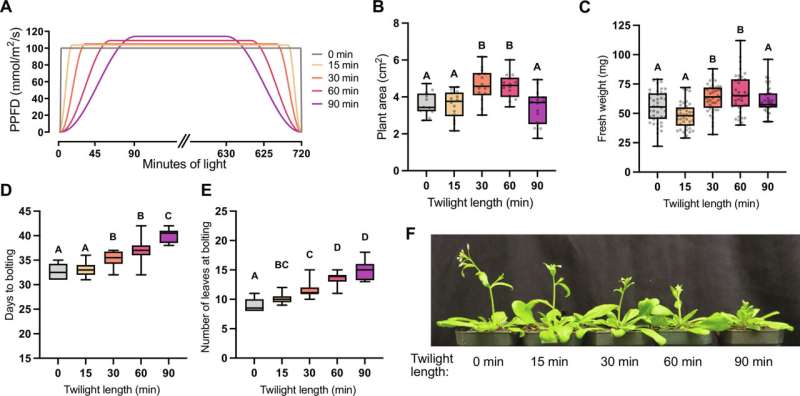This article has been reviewed according to Science X's editorial process and policies. Editors have highlighted the following attributes while ensuring the content's credibility:
fact-checked
peer-reviewed publication
trusted source
proofread
Researchers discover optimum twilight time for plant growth

A team of researchers has gained insight into the genetic processes underpinning how plants detect twilight and the role twilight plays in plant growth.
"We got these surprising findings that twilight has a very relevant effect on key agriculture traits such as flowering time and growth," says R. Glen Uhrig, an associate professor in the Department of Biological Sciences.
For the study, the researchers simulated twilight conditions in a controlled growth chamber and monitored the responses of the Arabidopsis plant, a model plant and relative of canola. The findings are published in the journal Science Advances.
They exposed the plants to progressively increasing twilight lengths (0 to 90 minutes) and noted the plants grew larger, with more flowers and more biomass with a 30-minute twilight compared with both shorter or longer durations—a finding that has incredible promise for agricultural breeding and horticultural plant growth, Uhrig says.
Crops grown in the field could be bred to be more responsive to twilight conditions, tailoring the time to harvest and increasing the crop yield—an issue facing global agriculture under a changing climate. For vertical farming or horticultural greenhouse operations, changes in the lighting conditions to incorporate twilight could produce similarly positive results and increased yield outcomes, he notes.
For decades, photoperiod (the period of time within a day that a plant is exposed to light) and temperature were two key environmental variables thought to affect plant growth, but not much was known about the impact of twilight due to technical limitations—it wasn't possible to simulate twilight conditions closely enough to yield accurate insight.
Advances in technology mean it's now possible to study twilight as an environmental variable. Uhrig and his team used equipment from G2V Optics to create six-band LED light "recipes" (particular combinations of light wavelengths and intensities) with fully programmable light intensity within a growth chamber.
"We wanted to understand how plants respond to twilight, which is essentially the ramping up of light in the morning and the ramping down of light in the evening, to see how that affects their growth and development."
The researchers measured plants by capturing images with an overhead camera and processing them using image analysis software to analyze their growth over time, along with a series of advanced molecular analysis tools.
As Uhrig explains, two key things occur in plants during twilight—light detection and photosynthesis. The light detection comes first and, when a certain amount of light intensity occurs, it triggers photosynthesis. While plants grew bigger and flowered more in response to the twilight conditions constructed for the study, these growth measures responded slightly differently to the various exposure times, suggesting twilight has a complex impact on plant growth and development.
"We think that's where twilight is coming in and separating the plant's light detection, which might be more associated with flowering time, from photosynthesis, which is more associated with growth."
They further explored the molecular mechanisms behind the observed responses by looking at a gene-deficient plant line with an altered circadian clock. "Plant growth and development are governed at the highest levels by the circadian clock," explains Uhrig.
"There's something incredibly interesting going on within this twilight period that has not been previously observed."
Uhrig acknowledges the outstanding contributions of the two post-doctoral fellows who were co-authors on the paper: Sabine Scandola, now a researcher at Agriculture and Agri-Food Canada, and Devang Mehta, who is now a professor at KU Leuven.
More information: Devang Mehta et al, Twilight length alters growth and flowering time in Arabidopsis via LHY / CCA1, Science Advances (2024). DOI: 10.1126/sciadv.adl3199
Journal information: Science Advances
Provided by University of Alberta




















